About I Ching...
| The I Ching, or, "Classic of Change", is one of the oldest known documents in the world.
It can be traced as far back as 3000 years in written form, and the Chinese claim that it was passed down as oral tradition for two thousand years before that.
Its longevity isn't the only wonder the I Ching holds claim to.
It also possesses the uncanny ability to actually communicate with anyone who chooses to use it.
This is no fortune-telling gimmick -- in fact, the I Ching often frustrates attempts to divine the future from its pages.
This oracle is solely concerned with the present -- YOUR present.
It takes you past the tunnel vision and gives you a 360 degree view of your situation.
It goes beyond the realm of your five senses and picks up the subliminal signals that sailed right past your conscious awareness to become filed away in your subconscious.
When you are obsessed with a desire, intent on an outcome, the I Ching gently nudges you and says, "Yes, but have you considered this ...?"
This classic's ability to accurately gauge a situation probably seemed like a gift from the gods to the sages who discovered it -- and in a sense, it is.
But modern science is progressively removing the layers of superstition from its legend and replacing it with new understanding that is no less magical.
Like all oracles of the ancient world, the I Ching's message is cloaked in ambiguity.
What makes this oracle ingenious, though, is that its symbols spark the universal archetypes embedded within the Collective Unconscious we all share.
The books of C.G. Jung, the father of modern psychoanalysis, shed light on these archetypes -- a subject much too complex to address here.Read his I Ching or Book of Changes (Arkana) . .
For a quick study, try the entertaining and enlightening writings of Joseph Campbell, for example The Power of Myth . .
Another secret of the I Ching's accuracy is its division into 64 sections, representing every situation in life that one might find oneself in.
What is truly brilliant about this classic's formula is that every one of these 64 situations can change into any one of the other 63!
Thus the classic's name, Change. |
|
Yin/Yang
| The I Ching illuminates the principles of the Tao, the universal flow that underlies all action and permeates all being.
These principles are most easily measured in the material world by yin and yang, the polar opposites.
It is the degree of yin and yang present in each of the 64 situations that defines it.
Each polarity helps define a situation, action, or being with its own respective traits, some of which are listed below. |
Yin |
Yang | negative
passive
female
receptive
dark
night
cold
soft
wet
winter
shadow
empty
moon
valley
nadir
introverted
reactive
backward
descending
intuitive
unconscious
depths
being | positive
aggressive
male
creative
light
day
heat
hard
dry
summer
radiance
filling
sun
summit
zenith
extroverted
active
forward
ascending
reasoning
conscious
heights
doing |
Lines
In the I Ching, the amount of yin or yang present in a given situation is represented by the lines making up that situation's hexagram.
|
 | A broken line represents yin. |  | A solid line represents yang. |
If either a yin or yang line is red, that line is a changing line, which will transform into its polar opposite during the course of your consultation. |
 | A red broken line represents a yin line that transformes into a yang line. |  | A red solid line represents a yang line that transformes into a yin line. |
Lines in your consultation are determined by each of six coin throws.
Trigrams |
A trigram is made up of any combination of three yin and yang lines.
In the interpretation of the eight trigrams there are two methods:
Polar: The Fu Hsi arrangement.
Cyclic: The King Wen arrangement.
The interpretation of the trigrams at I Ching Online is based on King Wen.
| 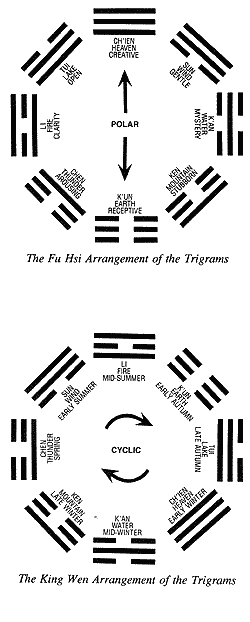 |
There are eight possible combinations, each with its own distinct attributes:
|
Hexagrams
A hexagram is made up of two trigrams, one atop the other, for example:
|
| | | | Line | | | Upper Trigram: |  |  | | Tui / Lake |  |  | | | |  |  | | | Lower Trigram: |  |  | | Chen / Thunder |  |  | | | |  |  | | | Hexagram 17: Sui / Following | |
It is read line-by-line, from bottom to top.
There are 64 hexagrams in all, each representing an archetypal situation in life.

Or in Chinese symbols:
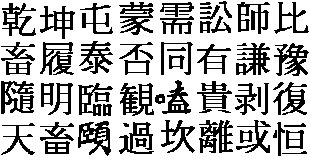
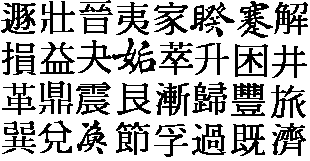
The meaning of each hexagram is affected by the presence of changing lines, which in turn point the way to a second, transformed hexagram.
In all, there are 4,096 possible core readings.
With the inclusion of symbols, nuclear trigrams, and other factors, the interpretation possibilities are pushed into the tens of millions.
Coin Method
When consulting the I Ching oracle, a hexagram is built one line at a time, from the bottom up, by throwing three coins.
One side of the coin represents yin 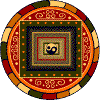 , the other yang , the other yang 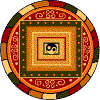 . .
Yin counts 2 and yang counts 3.
Throwing three coins at once makes four combinations possible:
|
3 yin (2+2+2)= 6 |    |  | changing yin | 2 yin, 1 yang (2+2+3)= 7 |    |  | pure yang | 2 yang, 1 yin (3+3+2)= 8 |    |  | pure yin | 3 yang (3+3+3)= 9 |    |  | changing yang |
|

No comments:
Post a Comment